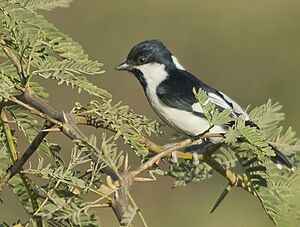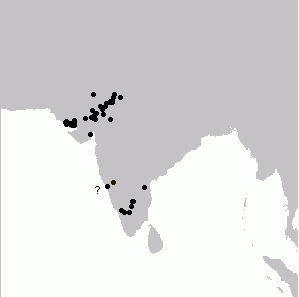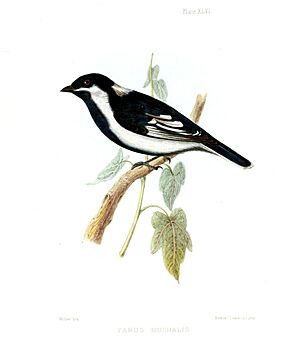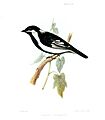White-naped tit facts for kids
Quick facts for kids White-naped tit |
|
|---|---|
 |
|
| Foraging on a Prosopis juliflora |
|
| Conservation status | |
| Scientific classification | |
| Genus: |
Machlolophus
|
| Species: |
nuchalis
|
 |
|
The white-naped tit (Machlolophus nuchalis) is a small bird from the tit family. It is sometimes called the white-winged tit. This special bird lives only in India. You can find it in dry, thorny forests. It lives in two separate areas: one in western India and another in southern India.
This bird is easy to spot because of its strong black and white patterns. It looks very different from other tits. The white-naped tit is quite rare. It is considered vulnerable because it needs special places to live. These places often include old tree holes made by woodpeckers for nests.
Contents
What is a White-Naped Tit?
The white-naped tit used to be part of a larger group of birds called Parus. But in 2013, scientists studied their DNA. They found that the white-naped tit and some other birds were different enough. So, they moved them to a new group called Machlolophus. This new group is a distinct family of birds.
How to Identify a White-Naped Tit
This bird is the only black-and-white tit in India. It has a black crown on its head. Its cheeks, throat, and a stripe down its belly are also black. The areas below its eyes and a patch on its neck are white. Its wings have white parts on the outer feathers. The two outer tail feathers are white too. The white on its sides can sometimes look a bit yellow.
Where White-Naped Tits Live
The white-naped tit was first found in the Eastern Ghats near Nellore. This was by a scientist named Thomas C. Jerdon in 1847. For a long time, people didn't see this bird much in southern India. Later, another scientist, Salim Ali, found them in the Biligirirangan Hills.
The bird also lives in the Kaveri valley area. In western India, it lives in places like Kutch, Rajasthan, and Haryana. Some old records from Bhutan are thought to be mistakes.
White-Naped Tit Behavior and Life
These birds usually live in small groups. They are quite shy. The best way to find them is by listening to their calls. Their calls sound like musical whistles, like "tee-whi-whi" or "see pit-pit-pit-pit".
They stay within their own areas. Pairs of birds will protect their territory from other tits. Both male and female birds use hollows in trees to sleep. They might use the same sleeping spot for many years! The male bird often goes with the female to her sleeping spot. Then he flies to his own spot.
What White-Naped Tits Eat
White-naped tits eat insects. They also enjoy berries from plants like Salvadora oleoides. Sometimes, they drink nectar from Capparis aphylla flowers. They will also visit puddles to drink water.
White-Naped Tit Reproduction
In Rajasthan, white-naped tits breed during the monsoon season. This is from May to August. They build their nests inside tree hollows. The nest is made of soft fibers and hair. They often use natural holes in trees. They also use holes made by woodpeckers. Nests have been found in old Salvadora persica and Boswellia serrata trees.
We don't know exactly how many eggs they lay. But adults have been seen with three young birds. The female bird sits on the eggs. It's not known if the male helps with this part. However, males do bring food to the female at the nest. Both parents help care for the baby birds. They feed the chicks with caterpillars. Parents might bring food to their young even late in the evening.
In Gujarat, these birds seem to rely on old woodpecker nests. They use these holes for both nesting and sleeping. It was once thought that these birds might fly from western to southern India. But this idea is not supported by observations. Birds, even young ones, have been seen in southern India during summer. Birds tagged in western India were found again close by. We still need to learn more about breeding in the southern population.
Conservation Status
The number of white-naped tits has gone down quickly recently. Their home, the dense Acacia scrub forest, is being damaged. This is especially true in western India. People collect old branches for firewood. These branches often have the tree holes that the tits need for nesting.
Images for kids





